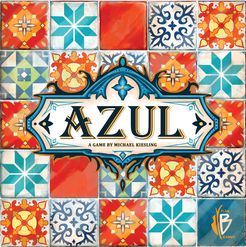
Players: 2-4
Play Time: 30-45 minutes
Designer: Michael Kiesling
Publisher: Next Move / Plan B
Year: 2017
Overview
Azul is one of the newest games in my (ever-growing) collection, and I can already tell I am going to be bugging my friends to play it. It seems deceptively simple, but I’m sure there are nuances and depth that I’ve not yet discovered. If not, well, I bet I will have played the game often enough to make it worthwhile. The game is a drafting game, meaning players take turn collecting components (tiles in this case) to play. Once the drafting is done, players hope to move their tiles onto their mosaic. The first to complete a row triggers the end-game scoring.
Each player has exactly the same board in the basic game. (There is an advanced mode where players make their own boards.) There are “factories” where tiles are made, and each player tries to pick up tiles that fit his or her layout at that time. As the game goes on, the number of options steadily decreases, which only serves to ratchet up the tension. As mentioned above, the game ends when at least one player has completed a full row of five tiles. This will take at least five turns but is probably going to be more.
On a turn, a player picks up all of the tiles of a single color from either a factory or the “leftover” pile. They must place all of those tiles onto their work area. Any tiles that don’t fit are prosaically dropped on the floor and broken, causing penalty points to be assessed during the scoring part of the round. You can stick an opponent with colors they can’t use if you’re careful and watch what is happening around you. 👿
Once the tiles are all selected, players move tiles from their work area onto their mosaic. There are specific rules as to how this works (which I won’t cover here). Scoring is based on Qwirkle-like rules where you get one point for each tile adjacent to your new tile in both horizontal (row) and vertical (column) form. The maximum points you could score would be 10, if you manage your placement just right. A tile by itself scores exactly one point.
Once at least one player has completed a row the bonus scoring beings. Each completed row is worth 2 points, a fully-completed column is worth 7 points, and for each color that is present on all five rows an additional bonus of 10 points is awarded.
Components
Fantastic! The game retails for about $40 (US) and they did not skimp on the components. There is a heavy-duty cloth drawstring bag for the tiles. The play boards (and factory tiles) are very thick and while cardboard feel like good quality. But it’s the tiles that make the game feel so nice. Rather than wood, which could potentially chip while being shuffled, the tiles are a hard resin / plastic. I have a newer version of the game where even the first-player tile is made out of resin. Top notch stuff.
Game Play / Rules / Complexity
We only referred to the rule-book a couple of times during our opening games, and now I’m done. I don’t think I’ll need the rule-book every again. Yet it feels like there are strategies and depths that will evolve as players become more comfortable with the game. There are elements of “take that” which could come into play; you certainly can’t ignore your neighbors and focus solely on what you are trying to do.
Experience
I liked the game. The tactile feel of the tiles really helped. I liked the fact that there is a base game to get you started (where everyone tries to complete the same design) but the play board flips over to provide a more difficult challenge. I would think that you could even do a mix of both; allowing beginner players to use the pre-built design while more experienced players could opt for the harder build-your-own design.
Overall Score
On the Board Game Geek scale I would currently rate this a strong 7, even perhaps an 8. I started playing the game with my older son (he didn’t have a choice; he was the only one home at the time). We forgot the bonus scoring rules, but even at that we had two very close games. Oh, we also forgot to put the first player tile in the “floor” area. But I think that’s all the mistakes we made.
I will definitely want to play this game again. It’s quick, it has surprising complexity, it’s colorful, and it’s pleasing to touch.